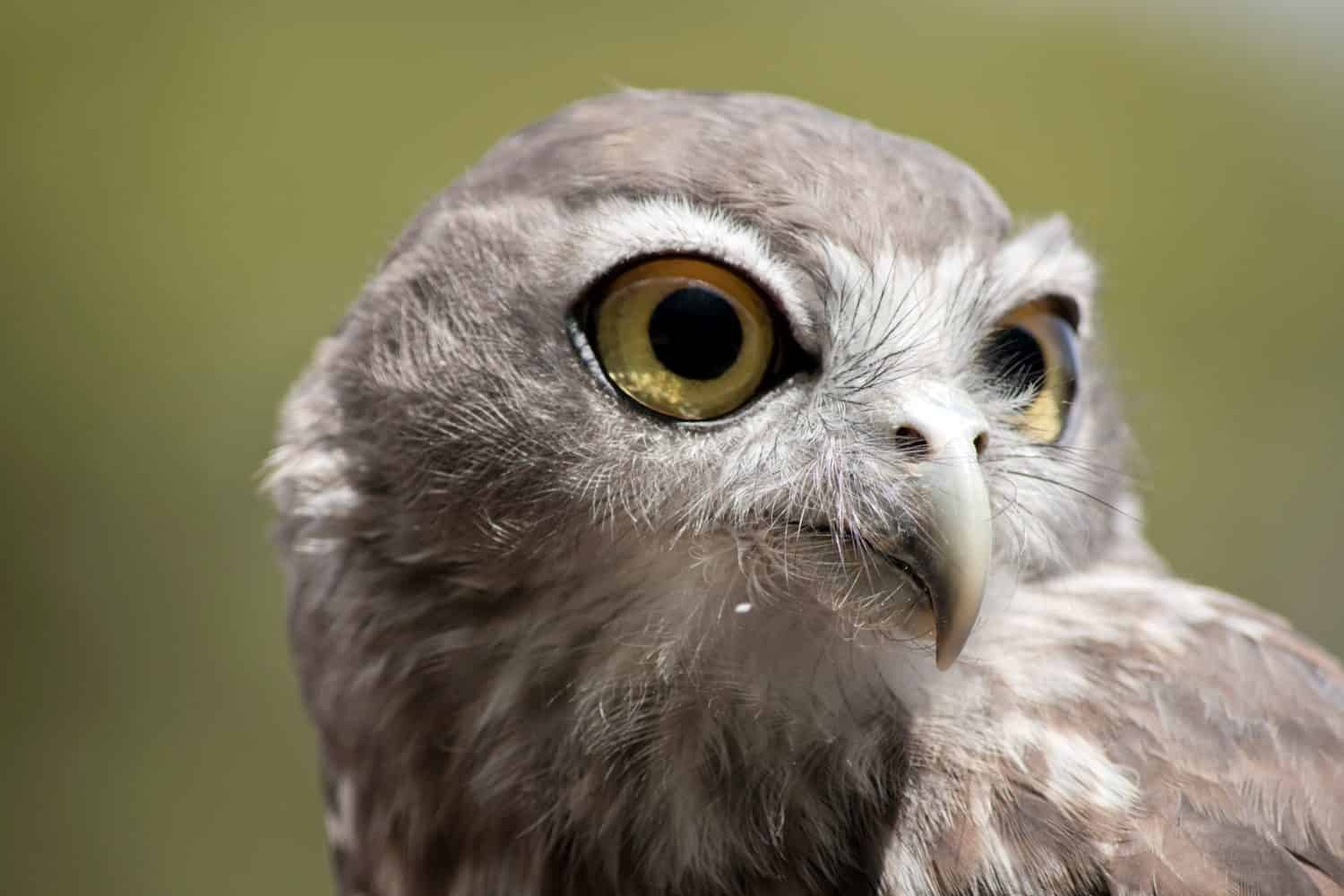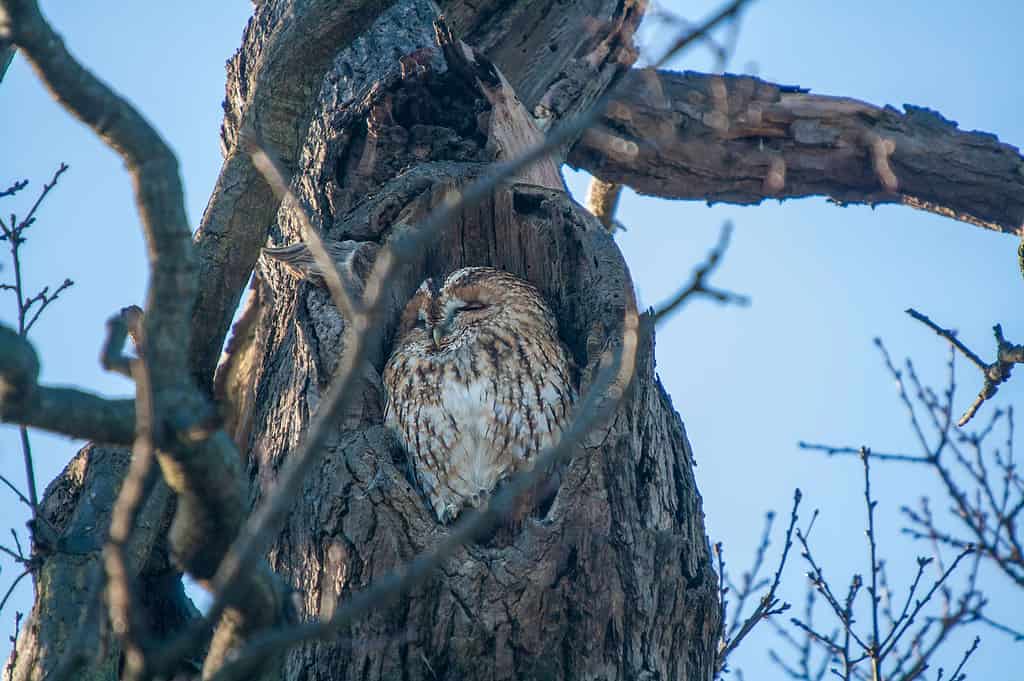With over 200 species spread across the globe, owls are famous for their exceptional sense of hearing and impressive vocal abilities. As creatures of the night, owls heavily rely on vocal cues to navigate their environment, communicate with mates, and defend their territories.
From haunting hoots to piercing shrieks, these nocturnal birds are skilled vocalists, each sound carrying a special message. In this article, we’ll be learning all about the diverse sounds owls make and the meaning behind each one. So take a look! By the time you’re done reading, you’ll know how to speak owl.
1. Hoot

Western screech owls are one of the species that uses hoots to communicate.
©Steve Bruckmann/Shutterstock.com
First on our list of sounds owls make we have the famous “hoot” or “who”. Western screech owls are one of the species that uses hoots to communicate. They produce a series of hoots that get progressively faster as the vocalization goes on. You can find western screech owls west of the Rockies, as well as along the Pacific coast.
Snowy owls are another species that loves to hoot. These birds have a circumpolar range that stretches throughout the northern regions of North America and Eurasia.
What owl hoots three times? Great horned owls. These birds let others know where they live by making low, gentle hoots. These vocalizations have a hypnotic and rhythmic pattern: “hoo-h’HOO-hoo”.
2. Toot

The tiny Northern saw-whet owl is famous for making a repetitive toot.
©Megan Lorenz/iStock via Getty Images
Along with saying “hoot”, owls also like to “toot”. The tiny Northern saw-whet owl is famous for making a repetitive toot. The sounds are comparable to the sound a saw makes sharpening on a whetstone. Their “toot-toot-toot-toot” call helps them establish their presence in a territory. Some of their favorite territories include coniferous forests throughout North America.
3. Hiss

Barn owls hiss as a way of scaring off anyone who intrudes on their nest.
© Henk Bogaard/ via Getty Images
A lot of animals hiss as a way of scaring off a potential threat. Snakes, giraffes, cats, and owls are all capable of hissing.
What owls hiss? For starters, there’s the burrowing owl. Their hissing sound is similar to that of a rattlesnake’s. This comes in handy when they need to defend their low-to-the-ground territory. Burrowing owls frequently roost in burrows that rattlesnakes use as well.
Barn owls also like to hiss as a way of scaring off anyone who intrudes on their nest. This species has one of the longer hissing vocalizations, with a single hiss sometimes lasting as long as four seconds.
Great horned owls spice up their hiss by throwing in other sounds. When defending their space this species will hiss and clack by snapping their beaks together. They also can produce bone-chilling wavering cries. Sometimes male and female great horned owls sing together, taking turns with their calls. You can tell apart the female’s voice since it is higher than the male’s.
4. Bark

The medium-sized barking owl sounds a lot like a dog crying out “woof-woof”.
©Susan Flashman/Shutterstock.com
Dogs aren’t the only ones who like to bark. True to its name, the medium-sized barking owl makes a distinct “woof-woof” vocalization. Males and females will bark together, and sometimes they throw in a fun “yowing” sound too. The “yowing” sounds a lot like someone calling out for help, which is why people call it the “screaming woman call”. This remarkable owl can be found in parts of New Guinea, Moluccas, and throughout Australia.
5. Who-Cooks-For-You-All

Barred owls have a complex call that sounds like, “who cooks for you all?”.
©FotoRequest/Shutterstock.com
A lot of owls make vocalizations that sound like English words, and sometimes even phrases. Take for instance the lovely barred owl. This species can vocalize well enough to sound like a person saying, “who-cooks-for-you”. And even though they aren’t songbirds, they use this call similar to how a songbird communicates.
Barred owls will call out in a series of hoots. The call is eight to nine notes long and carries far throughout the forest. When mating time rolls around males and females create duets of gurgles, caws, hoots, and cackles.
Similar to the great horned owl, barred owls also clack and snap when they’re unhappy. Adults and young birds will snap their bills in disapproval, especially during a disagreement.
6. Chatter

The adorable elf owl has a lovely chatter song.
©suchitra poungkoson/Shutterstock.com
If you need to see something adorable, just look up photos of the tiniest owl in the world — the elf owl. Found throughout the southwestern United States and Mexico, this species is famous for making a lot of chatter. Their chatter song has five to seven high notes that sound a bit like an excited dog yipping.
7. Twit-Too

The tawny owl’s “twit-too” call is a duet between a male and female.
©iStock.com/Rob Atherton
On an autumn evening deep in the woods, you might hear tawny owls calling out “twit-too”. This sing-song call is a duet between a male and female owl. The female makes the “twit” sound, and then the male responds with a wavering “twoo”. Sometimes, it can also sound like “ke-wick” or “hoo-hoo”.
Why do owls say “twit-too”? Well, this call has different meanings. The female uses it to get in touch with a male or to talk to her babies. On the other hand, male tawny owls use it to mark their territory.
8. Shriek

Barn owls live all over the world, except in Antarctica.
©Henk Bogaard/Shutterstock.com
Owls can make sounds that seem like they’re from a scary movie, like the eerie shriek of a barn owl. This loud cry can scare away predators and is also a form of communication between them. Barn owls live all over the world, except in Antarctica.
9. Coo-Coo

Burrowing owls live in North and South America, including the central and western U.S., and Florida.
©Bildagentur Zoonar GmbH/Shutterstock.com
If you’re in the woods and hear a call coming from the ground, it might be from a burrowing owl. Burrowing owls can be found across North and South America, including in the central and western U.S., as well as in Florida. Unlike most owls, they don’t live in trees but in burrows underground. Their call is a high-pitched “coo-coooooo”. Males use this call to defend their territory or to attract a mate.
10. Baby Owl Sounds

Young chicks will scream, screech, and shriek when they’re hungry.
©Lena Ostberg/Shutterstock.com
So far we’ve been discussing the sounds adult owls make. But what about the calls of young chicks?
How can you tell if you’re hearing a baby owl? Here are a few of their most common vocalizations:
- Screech
- Shriek
- Scream
- Hiss
- Whimper
- Hoot
Baby owls will screech and scream when they’re hungry, hiss when upset, and whimper to get attention. As baby great horned owls mature they become skilled vocalists, capable of producing a clear-sounding “hoot”.
The photo featured at the top of this post is © agustavop/iStock via Getty Images
Thank you for reading! Have some feedback for us? Contact the AZ Animals editorial team.






